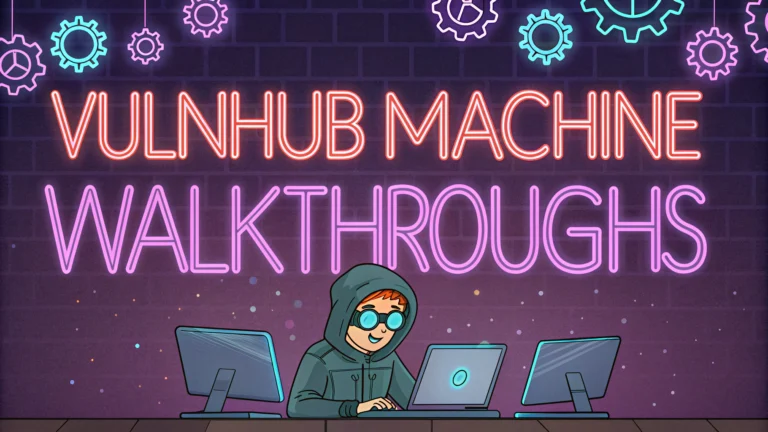VulnHub offers a treasure trove of vulnerable machines perfect for practicing penetration testing skills in a safe, legal environment.
This article breaks down proven strategies and methodologies for successfully completing VulnHub machine challenges, whether you’re a beginner or experienced penetration tester.
Understanding how to approach and solve these intentionally vulnerable machines helps build practical skills that translate directly to real-world penetration testing scenarios.
Getting Started with VulnHub Machines
Download and set up a penetration testing distribution like Kali Linux or ParrotOS as your attack platform.
Install VirtualBox or VMware to run the vulnerable machine images.
- Download machine images from VulnHub.com
- Import the .ova/.ovf file into your hypervisor
- Configure networking (usually NAT or Host-only)
- Take snapshots before starting for easy resets
Initial Enumeration Steps
Start with a network scan to identify the target machine’s IP address:
netdiscover -r 192.168.1.0/24Run an initial Nmap scan to identify open ports and services:
nmap -sC -sV -p- [target_ip]Common Attack Vectors
- Web application vulnerabilities (SQLi, XSS, File Upload)
- Default credentials
- Outdated software versions
- Misconfigured services
- Known CVE exploits
Essential Tools for VulnHub Machines
| Tool | Purpose |
|---|---|
| Gobuster/Dirbuster | Directory enumeration |
| Burp Suite | Web application testing |
| Metasploit | Exploitation framework |
| LinPEAS/WinPEAS | Privilege escalation |
Documentation Best Practices
Record every step of your penetration testing process using tools like CherryTree or SimpleNote.
- Screenshot important findings
- Document commands used
- Note failed attempts
- Track successful exploitation paths
Recommended Machines for Beginners
- Kioptrix Series (#1-#5)
- Basic Pentesting Series
- Mr-Robot
- Brainpan
Next Steps in Your Practice
Move on to platforms like HackTheBox or TryHackMe after mastering VulnHub basics.
Join the VulnHub community on Discord or Twitter to discuss solutions and get help when stuck.
Consider creating and submitting your own vulnerable machines to contribute to the community.
Advanced Exploitation Techniques
Understanding more sophisticated attack vectors enhances your ability to tackle complex VulnHub machines:
- Buffer overflow exploitation
- Reverse engineering binaries
- Custom exploit development
- Advanced web application attacks
Post-Exploitation Activities
Privilege Escalation
After gaining initial access, focus on elevating privileges through:
- SUID binary exploitation
- Kernel vulnerabilities
- Misconfigured permissions
- Credential harvesting
Lateral Movement
Practice moving across the network when multiple machines are present:
- Password cracking
- Token manipulation
- Service exploitation
Building a Methodology
Develop a systematic approach to machine completion:
- Information gathering
- Vulnerability assessment
- Exploitation planning
- Post-exploitation
- Documentation
Mastering the Craft
Success with VulnHub machines requires dedication, patience, and continuous learning. Regular practice builds muscle memory for common exploitation techniques while exposing you to new attack vectors.
Focus on understanding vulnerabilities rather than simply following walkthroughs. This deeper knowledge translates into real-world penetration testing competency and professional growth in information security.
Remember to always operate within legal boundaries and use these skills ethically to contribute to a more secure digital environment.
FAQs
- What is VulnHub and how does it help in penetration testing?
VulnHub is a platform providing downloadable vulnerable virtual machines designed for security professionals and enthusiasts to practice legal hacking, penetration testing, and vulnerability assessment in a controlled environment. - What tools are commonly needed for VulnHub machine penetration testing?
Essential tools include Nmap for port scanning, Metasploit Framework for exploitation, Burp Suite for web application testing, Wireshark for network analysis, and various password crackers like John the Ripper and Hydra. - How do I set up VulnHub machines in my testing environment?
You need a virtualization platform like VirtualBox or VMware, download the machine from VulnHub, import it into your hypervisor, and ensure it’s on an isolated network with your attack machine (typically Kali Linux). - What are the common initial enumeration steps for VulnHub machines?
Start with network scanning using Nmap to identify open ports and services, conduct service version detection, check for web applications, and perform directory enumeration if web services are present. - How should I document my VulnHub machine penetration testing process?
Document all commands used, screenshots of critical findings, enumeration results, exploitation attempts, privilege escalation steps, and maintain a chronological record of your methodology. - What are common privilege escalation techniques used in VulnHub machines?
Common techniques include exploiting SUID binaries, misconfigured sudo permissions, cronjobs, weak file permissions, kernel exploits, and vulnerable services running with root privileges. - How can I identify the difficulty level of a VulnHub machine?
VulnHub machines typically include difficulty ratings in their descriptions, and community feedback/walkthroughs can provide insights into the complexity and required skill level. - What should I do if I get stuck while solving a VulnHub machine?
Review your enumeration results thoroughly, check for overlooked information, consult the machine’s hints if provided, and as a last resort, review community walkthroughs while learning from the process. - Are VulnHub machines similar to real-world penetration testing scenarios?
While VulnHub machines are deliberately vulnerable and sometimes contain CTF-style challenges, many replicate real-world vulnerabilities and security misconfigurations found in actual systems. - What are the legal considerations when working with VulnHub machines?
VulnHub machines should only be used in isolated, controlled environments. The techniques learned should not be applied to systems without explicit permission, as unauthorized hacking is illegal.







